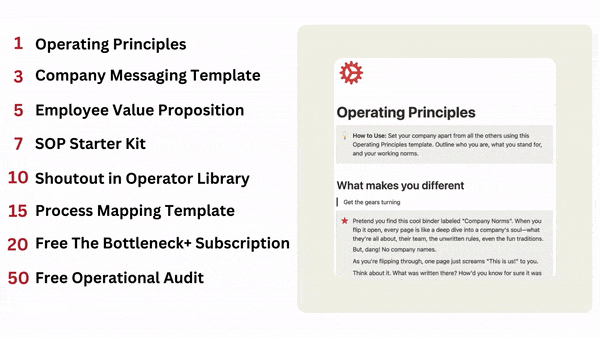
Together With

Read Time: 5.1 Minutes
Good Morning Operators ⚙️
I’m going to keep the intro short today.
My baby daughter decided to arrive a bit earlier than expected!
As of yesterday morning, I have become a father. Thanks everyone for the support over these past few months.
As I ponder what being a dad means, here are today’s topics:
Automating client emails
Testing community
Pulse checks
Let’s jump in.

Together With Supertalent
Save 20+ Hours a week
Supertalents handpicked library of 65+ Executive Assistant Playbooks is your key to mastering delegation.
Designed for busy entrepreneurs, these guides will optimize your time and energy, letting you focus on what matters.
Connect with a top-tier executive assistant and see the difference.

1. Automating Client Email Requests
Insight from Rameel Sheikh
Once upon a time, fresh new grad Rameel was on the account management team for Uber Freight.
I received 200 to 300 daily emails that required a response within the first 10 minutes of a customer reaching out.
I also helped with financial analysis, A/B testing customer experiences, and dashboard creation for leadership.
As you can imagine, these client communications were distracting (but of course, super important).
So, how do we balance quick responses with focus?
Don't be like me by manually doing everything.
Automate.
Let’s bring Zapier, ChatGPT and Slack (our favorite communication tool) into the mix.
Here’s how this automation works:
When a client e-mails support@[my domain].com, forward it to Zapier
ChatGPT (Zapier Action): Prompt: “Summarize the request the client is making in this email: [email contents]”
ChatGPT (Zapier Action): Prompt: “Write a brief e-mail response to the message below, letting the client know we are working on their request and suggesting anything the client might do to resolve the issue themselves.”
Slack (Zapier Action): Send a message to a public channel (#support): “New Support Request from [email address, pulled from Step 1] – [Reply from Step 2]. Potential Quick Response – [Reply from Step 3]
This ensures that your team is always:
Up to date on support requests
Rarely has to spend time opening their email (or a support ticket tool)
Deciphering strange requests (the summary step handles that)
Has a reasonable draft response ready instantly.
And if a team member wants to ignore support for a while, they can just mute the #support channel in Slack.
2. Testing a Community
Insight from April MacLean
Community building is a key unlock for your business.
Especially if you have a product-led growth business model.
More people recommending your product = more revenue for you.
Everyone's natural instinct is to throw together a discord chat and call it a day.
That's a terrible experience for your current and potential customers.
Only focus on one thing: the promise.
What do you promise you will assist with vs what members need to do themselves?
Once you have an idea for a community and potential members, try this to get critical insights.
Here are things to consider:
Skip the Jargon: Your community isn't impressed by fancy words. Craft your messages like you're talking to a homie.
Make a Cold Connection Warm: Cold invites don't work with strangers (or even acquaintances!). Choose folks who you can trust or who have the context to your invite.
Start Small: Build a small event instead of a massive one. Host a micro-event, a virtual coffee chat or a local meetup. These types of events are manageable, help you learn, and create a ripple effect for larger successes.
3. Your Team Pulse Check
Insight from Dave Kline
Try creating a pulse check to always know what your teams are doing.
It's a simple survey that you can run once a quarter to check on the vitals of your team and take proactive action.
Here are 11 questions you can use to create survey for your team:
I understand and am motivated by the team's mission.
At least 80% of my work contributes directly to that mission.
I know what is expected of me at work.
I have the tools, access, and support to meet my goals excellently.
My important work energizes me.
I have received recognition or praise for doing good work in the last seven days.
In the last seven days, I have received constructive feedback to improve.
I am clear and excited about how I can best develop.
I have consistent opportunities at work to learn and develop.
I feel cared for by my supervisor and colleagues.
I see consistent commitment from my colleagues to doing excellent work.
4. Market Map Matrix
Insight from Patticus
Traditionally you are told that there are 4 types of competitors – direct, indirect, potential, and substitutes. This framework doesn't work because this shows your view of the market, not your customers.
Try this instead:

This matrix maps your competitors on the only axes that truly matter – Market Mindshare (eg. how aware are customers of the competitor) and Resource Strength (eg. how much money is the competitor dedicating to the market).

Tool of the Week*
As I grow the newsletter (over 10,000 strong 💪 ), I’ve been deep-diving into how to automate my account payables.
Friends have been recommending DOKKA as a tool to make my account payable process fast.
How does it work?
DOKKA fetches vendor invoices from multiple data sources (including email).
Using AI, the tool captures the invoice data in seconds, regardless of its layout and language.
The transaction (along with the invoice) then gets automatically uploaded into your ERP.
It's like a turbo boost for your accounts payable.
Just hook the tool up to your current accounting software or ERP, and bam!
You're in for a smoother ride with automated invoice processing, streamlined approval workflows, and that nifty 3-way matching feature.
It's a game-changer. Interested in demoing the product? Click down below.

Operators Library
P.S. To get featured in this section, share the newsletter 10 times (your referral link is below), and I'll include you in a future issue.

How I Can Help
In case you're new: Who's The Bottleneck?
We’re on a mission to help you build, manage, and scale your startup.
We share high-quality, vetted, and actionable operational content as we learn it from the top 1% of operators.
How we can help you scale:
Upgrade to premium to get access to exclusive content, tools and more here
👀 Get your product in front of startup operators by sponsoring this newsletter.
🤝 Grab time with me for a 1:1 session


Support
Small ask: If you enjoyed today’s post, I’d be incredibly grateful if you helped others discover The Bottleneck. Please hit me with a fav or repost on my tweet below.

Spread The Word
Share The Bottleneck with friends to get a few freebies. Maybe you’ll make some new ones on the way 😆
We’ll give you free stuff and more friends if you share a link. Only one link.

{{rp_personalized_text}}


